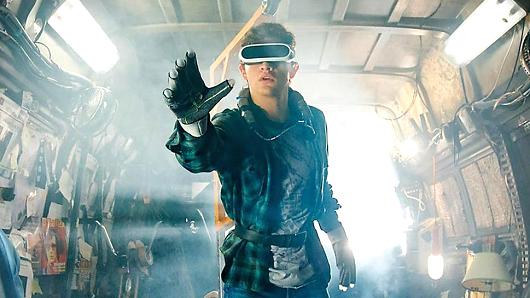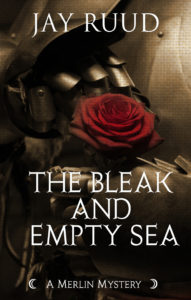Ready Player One
Steven Spielberg (2018)
[av_image src=’http://jayruud.com/wp-content/uploads/2014/08/Tennyson-180×180.jpg’ attachment=’77’ attachment_size=’square’ align=’left’ animation=’left-to-right’ link=” target=” styling=” caption=’yes’ font_size=” appearance=’on-hover’]
The box office champion of this past weekend by a wide margin was Steven Spielberg’s newest effort, Ready Player One, a slick CGI extravaganza bringing to the screen Ernest Cline’s 2011 best-selling novel of the same name. Now let me just say that my awesome wife doesn’t much like young-adult novels in general, really hates dystopian fiction in particular, and has never understood why anyone would waste his time playing video games. So, we can safely say that she is not the intended audience for this film—and, if you feel the same way, then neither are you. After a bit of cajoling, however, I was able to get her to agree to come with me to a local screening of the movie (hey, it’s Steven Spielberg after all. And maybe some of the nostalgic ’80s references would strike her fancy). Let me just say, though, that expectations were not high as we entered the cinema.
Turns out that, despite all the bells and whistles, Ready Player Oneis essentially an archetypal quest narrative: The hero must pass through many challenges and overcome many dangers in order to reach the goal: conquer the dragon, destroy the One Ring, defeat the Death Star, find the Ark of the Covenant, the Holy Grail, or, in this case, the vast treasure.
The story begins in 2045—years, we are told, after the “corn syrup droughts” and “bandwidth riots.” In Columbus, Ohio, the fastest growing city on earth, Wade Watts (Tye Sheridan of X-Men:Apocalypseand Mud), an orphaned teenager, lives with his Aunt Alice in “The Stacks”—a Columbus slum consisting of endless piles of trailer houses stacked one upon another (I couldn’t help thinking that one tornado would destroy everything in that area). Whether Wade ever goes to school or not, or whether most people have any kind of job, is anybody’s guess—you can’t tell from the movie. It’s a world in which human life has become so onerous, devoid of meaning or joy, that all anybody in Columbus seems to want to do is don a headset and enter a virtual world called the Oasis. Here you can be anything you want, do anything you want, in a world that seems a combination of every kind of video game ever conceived. Who needs drugs when everyone is addicted to virtual reality? Who needs reality?
The Oasis was the brainchild of a socially challenged geek-genius named James Halliday (played by Mark Rylance, an Academy-Award winner for Spielberg’s Bridge of Spies). Halliday has been dead for seven years, but upon his death he announced that he had created a game within Oasis that challenged any player to find three keys (what gamers would refer to as “Easter Eggs”—perhaps that’s why the film premiered on Easter weekend?) within his virtual world that, when found, would unlock his fortune—that is, the first person to find the keys and unlock the secret would inherit ownership of the Oasis, a fortune with the estimated value of half a trillion dollars. After seven years, no one has found even the first key, though nearly everyone is looking, including a whole army of minions of an evil capitalistic giant called IOI (Innovative Online Industries).
Wade, of course, is deeply into the game himself through his avatar Parzival. So is his muscular online Avatar friend Aech (Lena Waithe, best known from TV’s Master of None, for which she also won a Writing Emmy) and Aech’s warrior sidekick Avatars Daito (Win Morisaki) and Sho (Phiip Zhao). But his chief competition is actually the Avatar Art3mis (Olivia Cooke from TV’s BatesMotel). Art3mis, named for the Greek goddess of the hunt, is avidly on the hunt in this game. But when Wade’s superior knowledge of Halliday’s biography and habits enables him to figure out how to solve the puzzle of the first key, he becomes a target for the head of the real-world corporate giant IOI, Nolan Sorrento (Ben Mendelsohn of Darkest Hourand RogueOne) in the realworld, since IOI needs to control the Oasis in order to control the real-world economy. So the film develops into a quest on two fronts: Parzival’s virtual quest to find the keys and unlock the treasure, and Wade’s real-world quest to escape the IOI killers and prevent Sorrento’s push for world domination—a quest that requires him to seek out the real-world versions of his Avatar friends. He has, of course, fallen in love with the Avatar Art3mis by this time, but has been sharply warned by Aech that Avatars can be completely different from their real-world counterparts, and that Art3mis might be a 300-pound fan-boy couch potato.
I won’t reveal any more of the plot of this film, though from what I’ve already told you, you can probably figure the major stuff out for yourself, because it is pretty predictable. For me a lot of the interest in the film comes from its reworking of the traditional grail-quest narrative. The features of the grail legend are all here: There is, first a vast Waste Land that is the contemporary real world of Columbus and the stacks. In the grail legend, the grail knight (whose name in the early versions of the legend is Perceval or, in Wolfram von Eschenbach’s—and Richard Wagner’s—German versions, Parzival) has the task of finding the grail (in this version the keys), which will restore the health of the wounded Fisher King, and consequently also restore fertility to the Waste Land (an Oasisis a fertile spot in a desert or Waste Land, suggesting the water that might be associated with a “fisher king.”). In the original version of the grail story, Perceval is confronted unwittingly with a test, which he fails to pass and so fails in the quest. Halliday is the Fisher King in this instance, and his wounds were psychological. It is Wade/Parzival who figures out the great regret of Halliday’s life, his psychic wound, and uses his knowledge to pass a final test.
So that was my biggest take-away from the film. But I suspect for most people it will be the pop-culture allusions with which Halliday, and Spielberg, have filled the Oasis, stemming mainly from the ’80s or the late ’70s: Parzival rides around in a Delorean that seems straight out of Back to theFuture, and there is a major tribute to Stanley Kubrick’s TheShining, but those are only the most prominent references in what amounts to a visual phantasmagoria of pop-cultural trivia that includes The Iron Giant, Saturday Night Fever, Ferris Bueller’s Day Off, Star Wars, The A-Team, Willy Wonka and the Chocolate Factory, King Kong, Bill and Ted’s Excellent Adventure, Nightmare on Elm Streetand on and on, while the soundtrack blasts the Bee Gees, Duran Duran, Van Halen, Michael Jackson, etc. etc. etc. If you grew up in the ’80s you will almost certainly watch this movie with a rush of nostalgia.
That’s actually both a blessing and a curse for the movie. If the film is in part a warning about the tendency in contemporary society to allow our online lives to interfere with or even transcend our real lives, not unlike a drug addiction, and what that tendency might look like if it continued to expand for another 25 to 30 years, Spielberg has made the Oasis so attractive in this film that we really don’t care all that much about the real lives of the characters, and there’s something of a let-down when the action returns to mundane reality. He’s made the addiction so much more enticing than the sober life that nobody would want to be sober. Or if the film is a warning against corporate America (represented by IOI) running our lives, it seems perversely to push us into the arms of Google, Nintendo, Sony and Microsoft.
Still, it’s an entertaining film that most people will probably like. Even my skeptical wife admitted it was much better than she had expected—though since her expectations were pretty low to begin with, that wasn’t saying a whole lot. Rylance is painfully effective in his role as the unsociable genius. Sheridan and Cooke are sympathetic enough as the young lovers, and Mendelsohn hits all the right notes as the corporate baddie. A welcome Simon Pegg is likeable in a small but important role as Halliday’s original partner from whom the inventor had split in mid-career. But the fact is that nobody in this film is able to do much with a character in the real world because everybody is too busy being an Avatar. It’s definitely not a film about character.
So…this isn’t Schindler’s List, folks. Nor is it Jaws or E.T. It’s more of a Jurassic Park, relying pretty heavily on visuals and on a predictable but archetypal story. I’m giving it three Tennysons. You’re probably going to like it if you see it.
NOW AVAILABLE:
If you like these reviews, you might enjoy Jay Ruud’s most recent novel, now available from the publisher at https://encirclepub.com/product/the-bleak-and-empty-sea/. Also available from Amazon or Barnes and Noble.
When word comes to Camelot that Sir Tristram has died in Brittany of wounds suffered in a skirmish, and that his longtime mistress, La Belle Isolde, Queen of Cornwall, has subsequently died herself of a broken heart, Queen Guinevere and her trusted lady Rosemounde immediately suspect that there is more to the story of the lovers’ deaths than they are being told. It is up to Merlin and his faithful assistant, Gildas of Cornwall, to find the truth behind the myths and half-truths surrounding these untimely deaths. By the time they are finally able to uncover the truth, Gildas and Merlin have lost one companion and are in danger of losing their own lives.
Order Tramadol Online Overnight Order from Amazon here: https://www.amazon.com/Bleak-Empty-Sea-Tristram-Mystery/dp/1893035735/ref=sr_1_1?s=books&ie=UTF8&qid=1503328086&sr=1-1&keywords=Bleak+and+Empty+Sea
Order from Barnes and Noble here: https://www.barnesandnoble.com/w/the-bleak-and-empty-sea-jay-ruud/1126958139?ean=9781893035737


